Supply Chain Management Report: Starwood's Bed Linen and Terry Cloth
VerifiedAdded on 2020/04/15
|9
|2655
|98
Report
AI Summary
This report provides a comprehensive analysis of Starwood's supply chain management, specifically focusing on the sourcing of bed linens and terry cloth. It begins by examining the company's cooperative orientation, emphasizing the benefits of trust and transparency in supplier relationships. The report then delves into the critical information Starwood should share with its suppliers, while also addressing the associated risks, such as data security and competitive threats. It explores various sourcing methods, including requests for proposals and reverse auctions, and the circumstances under which Starwood might change suppliers. Finally, the report outlines key performance evaluation metrics that Starwood could use to assess its suppliers in the bed linen and terry cloth sector, including lead times, quality, and cost compliance, ultimately aiming to improve the overall effectiveness of the supply chain.
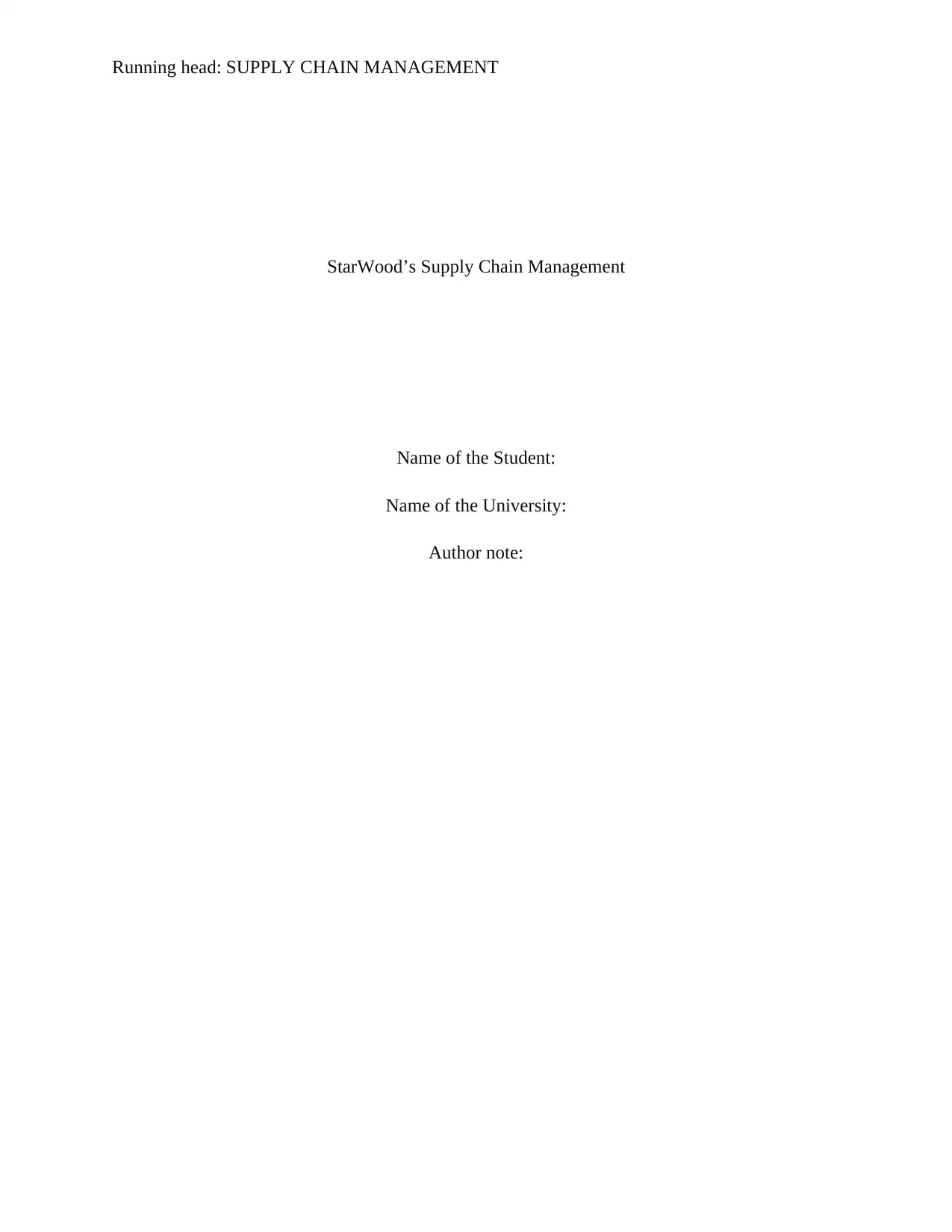
Running head: SUPPLY CHAIN MANAGEMENT
StarWood’s Supply Chain Management
Name of the Student:
Name of the University:
Author note:
StarWood’s Supply Chain Management
Name of the Student:
Name of the University:
Author note:
Paraphrase This Document
Need a fresh take? Get an instant paraphrase of this document with our AI Paraphraser
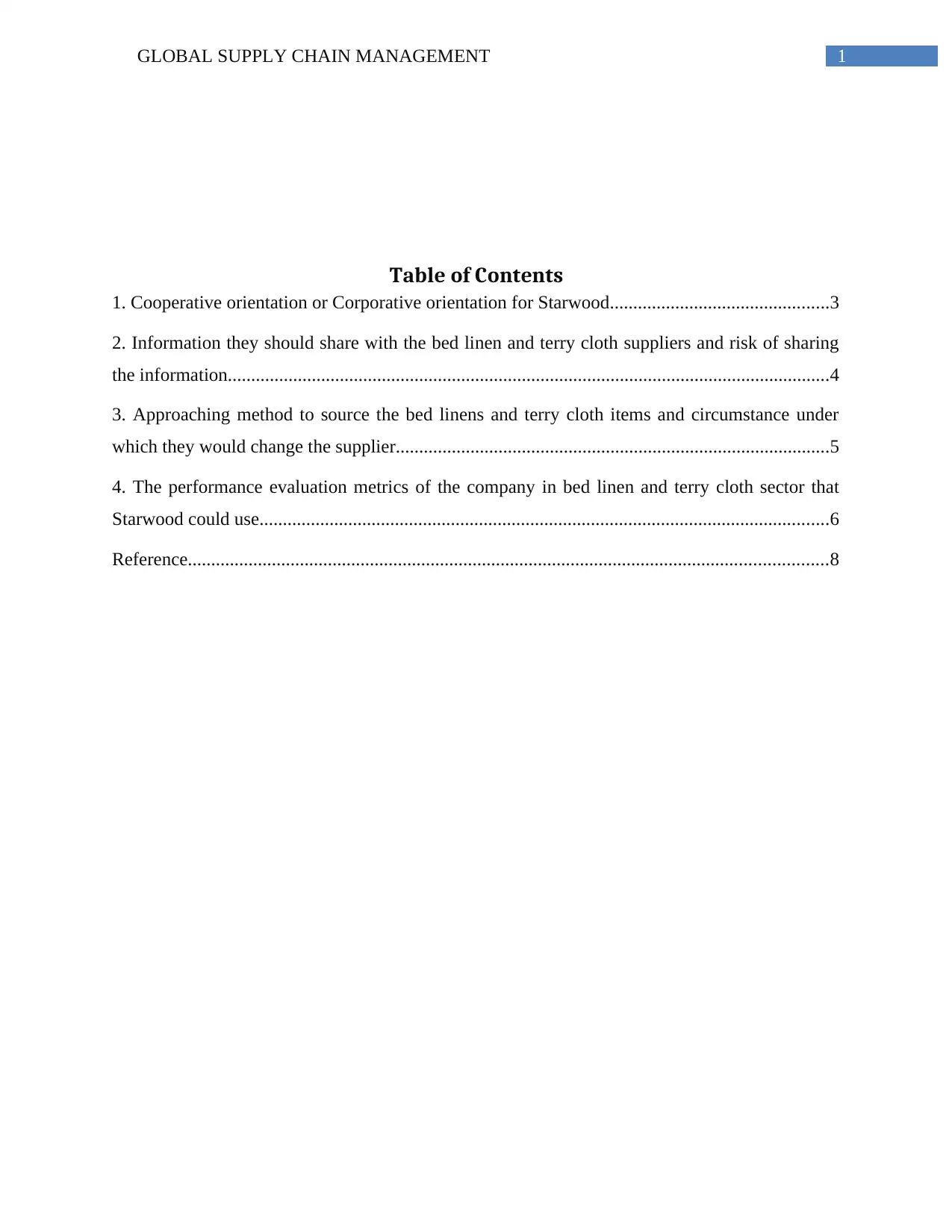
1GLOBAL SUPPLY CHAIN MANAGEMENT
Table of Contents
1. Cooperative orientation or Corporative orientation for Starwood...............................................3
2. Information they should share with the bed linen and terry cloth suppliers and risk of sharing
the information.................................................................................................................................4
3. Approaching method to source the bed linens and terry cloth items and circumstance under
which they would change the supplier.............................................................................................5
4. The performance evaluation metrics of the company in bed linen and terry cloth sector that
Starwood could use..........................................................................................................................6
Reference.........................................................................................................................................8
Table of Contents
1. Cooperative orientation or Corporative orientation for Starwood...............................................3
2. Information they should share with the bed linen and terry cloth suppliers and risk of sharing
the information.................................................................................................................................4
3. Approaching method to source the bed linens and terry cloth items and circumstance under
which they would change the supplier.............................................................................................5
4. The performance evaluation metrics of the company in bed linen and terry cloth sector that
Starwood could use..........................................................................................................................6
Reference.........................................................................................................................................8
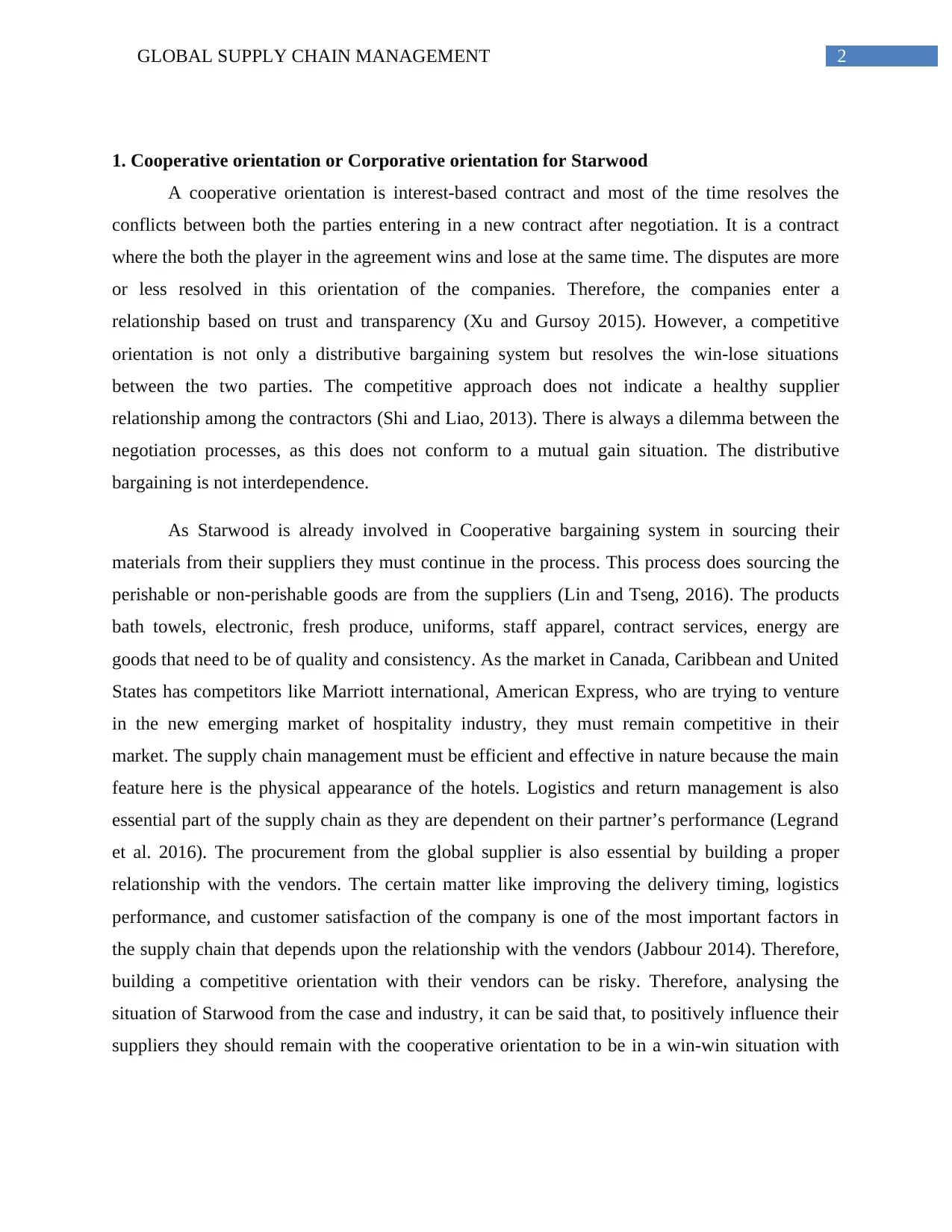
2GLOBAL SUPPLY CHAIN MANAGEMENT
1. Cooperative orientation or Corporative orientation for Starwood
A cooperative orientation is interest-based contract and most of the time resolves the
conflicts between both the parties entering in a new contract after negotiation. It is a contract
where the both the player in the agreement wins and lose at the same time. The disputes are more
or less resolved in this orientation of the companies. Therefore, the companies enter a
relationship based on trust and transparency (Xu and Gursoy 2015). However, a competitive
orientation is not only a distributive bargaining system but resolves the win-lose situations
between the two parties. The competitive approach does not indicate a healthy supplier
relationship among the contractors (Shi and Liao, 2013). There is always a dilemma between the
negotiation processes, as this does not conform to a mutual gain situation. The distributive
bargaining is not interdependence.
As Starwood is already involved in Cooperative bargaining system in sourcing their
materials from their suppliers they must continue in the process. This process does sourcing the
perishable or non-perishable goods are from the suppliers (Lin and Tseng, 2016). The products
bath towels, electronic, fresh produce, uniforms, staff apparel, contract services, energy are
goods that need to be of quality and consistency. As the market in Canada, Caribbean and United
States has competitors like Marriott international, American Express, who are trying to venture
in the new emerging market of hospitality industry, they must remain competitive in their
market. The supply chain management must be efficient and effective in nature because the main
feature here is the physical appearance of the hotels. Logistics and return management is also
essential part of the supply chain as they are dependent on their partner’s performance (Legrand
et al. 2016). The procurement from the global supplier is also essential by building a proper
relationship with the vendors. The certain matter like improving the delivery timing, logistics
performance, and customer satisfaction of the company is one of the most important factors in
the supply chain that depends upon the relationship with the vendors (Jabbour 2014). Therefore,
building a competitive orientation with their vendors can be risky. Therefore, analysing the
situation of Starwood from the case and industry, it can be said that, to positively influence their
suppliers they should remain with the cooperative orientation to be in a win-win situation with
1. Cooperative orientation or Corporative orientation for Starwood
A cooperative orientation is interest-based contract and most of the time resolves the
conflicts between both the parties entering in a new contract after negotiation. It is a contract
where the both the player in the agreement wins and lose at the same time. The disputes are more
or less resolved in this orientation of the companies. Therefore, the companies enter a
relationship based on trust and transparency (Xu and Gursoy 2015). However, a competitive
orientation is not only a distributive bargaining system but resolves the win-lose situations
between the two parties. The competitive approach does not indicate a healthy supplier
relationship among the contractors (Shi and Liao, 2013). There is always a dilemma between the
negotiation processes, as this does not conform to a mutual gain situation. The distributive
bargaining is not interdependence.
As Starwood is already involved in Cooperative bargaining system in sourcing their
materials from their suppliers they must continue in the process. This process does sourcing the
perishable or non-perishable goods are from the suppliers (Lin and Tseng, 2016). The products
bath towels, electronic, fresh produce, uniforms, staff apparel, contract services, energy are
goods that need to be of quality and consistency. As the market in Canada, Caribbean and United
States has competitors like Marriott international, American Express, who are trying to venture
in the new emerging market of hospitality industry, they must remain competitive in their
market. The supply chain management must be efficient and effective in nature because the main
feature here is the physical appearance of the hotels. Logistics and return management is also
essential part of the supply chain as they are dependent on their partner’s performance (Legrand
et al. 2016). The procurement from the global supplier is also essential by building a proper
relationship with the vendors. The certain matter like improving the delivery timing, logistics
performance, and customer satisfaction of the company is one of the most important factors in
the supply chain that depends upon the relationship with the vendors (Jabbour 2014). Therefore,
building a competitive orientation with their vendors can be risky. Therefore, analysing the
situation of Starwood from the case and industry, it can be said that, to positively influence their
suppliers they should remain with the cooperative orientation to be in a win-win situation with
⊘ This is a preview!⊘
Do you want full access?
Subscribe today to unlock all pages.

Trusted by 1+ million students worldwide
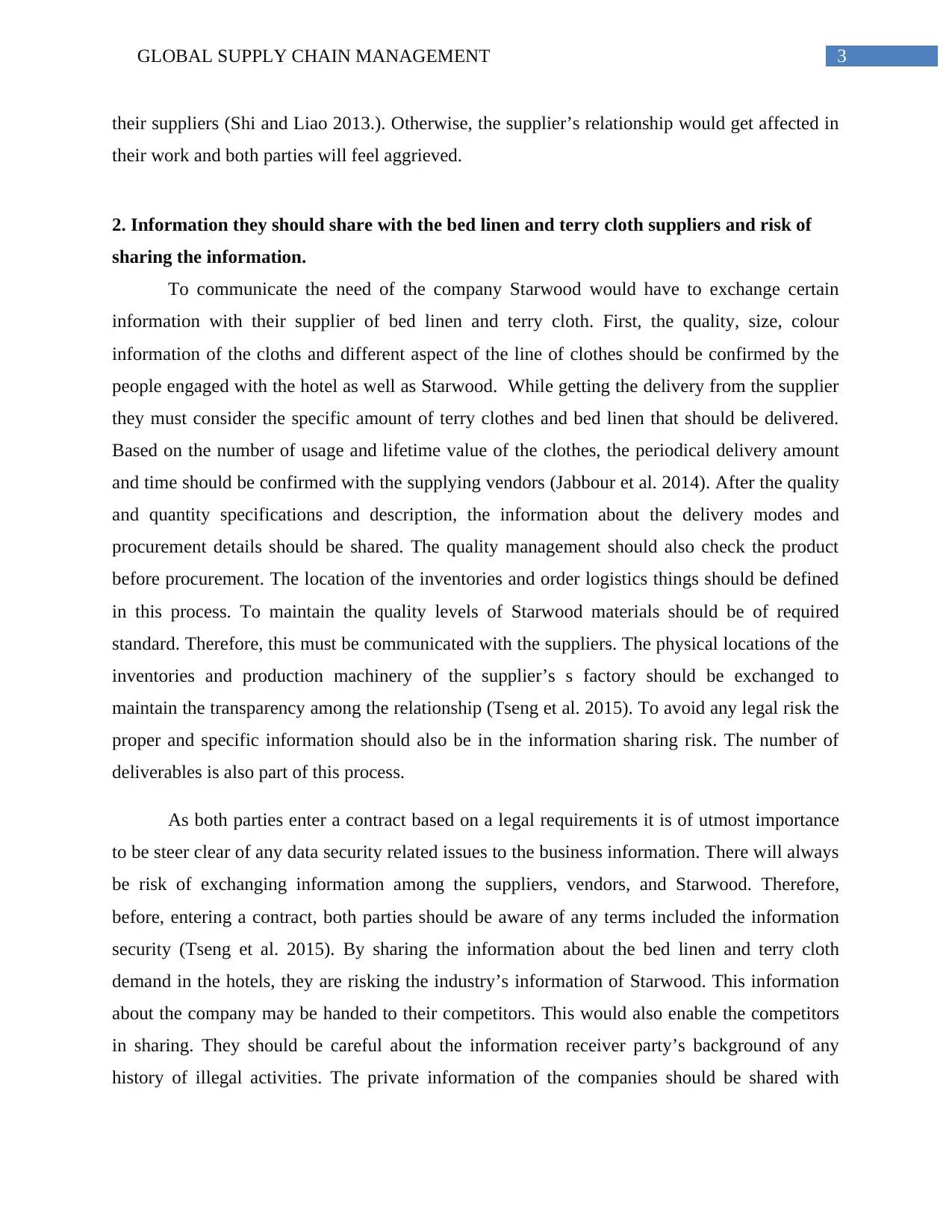
3GLOBAL SUPPLY CHAIN MANAGEMENT
their suppliers (Shi and Liao 2013.). Otherwise, the supplier’s relationship would get affected in
their work and both parties will feel aggrieved.
2. Information they should share with the bed linen and terry cloth suppliers and risk of
sharing the information.
To communicate the need of the company Starwood would have to exchange certain
information with their supplier of bed linen and terry cloth. First, the quality, size, colour
information of the cloths and different aspect of the line of clothes should be confirmed by the
people engaged with the hotel as well as Starwood. While getting the delivery from the supplier
they must consider the specific amount of terry clothes and bed linen that should be delivered.
Based on the number of usage and lifetime value of the clothes, the periodical delivery amount
and time should be confirmed with the supplying vendors (Jabbour et al. 2014). After the quality
and quantity specifications and description, the information about the delivery modes and
procurement details should be shared. The quality management should also check the product
before procurement. The location of the inventories and order logistics things should be defined
in this process. To maintain the quality levels of Starwood materials should be of required
standard. Therefore, this must be communicated with the suppliers. The physical locations of the
inventories and production machinery of the supplier’s s factory should be exchanged to
maintain the transparency among the relationship (Tseng et al. 2015). To avoid any legal risk the
proper and specific information should also be in the information sharing risk. The number of
deliverables is also part of this process.
As both parties enter a contract based on a legal requirements it is of utmost importance
to be steer clear of any data security related issues to the business information. There will always
be risk of exchanging information among the suppliers, vendors, and Starwood. Therefore,
before, entering a contract, both parties should be aware of any terms included the information
security (Tseng et al. 2015). By sharing the information about the bed linen and terry cloth
demand in the hotels, they are risking the industry’s information of Starwood. This information
about the company may be handed to their competitors. This would also enable the competitors
in sharing. They should be careful about the information receiver party’s background of any
history of illegal activities. The private information of the companies should be shared with
their suppliers (Shi and Liao 2013.). Otherwise, the supplier’s relationship would get affected in
their work and both parties will feel aggrieved.
2. Information they should share with the bed linen and terry cloth suppliers and risk of
sharing the information.
To communicate the need of the company Starwood would have to exchange certain
information with their supplier of bed linen and terry cloth. First, the quality, size, colour
information of the cloths and different aspect of the line of clothes should be confirmed by the
people engaged with the hotel as well as Starwood. While getting the delivery from the supplier
they must consider the specific amount of terry clothes and bed linen that should be delivered.
Based on the number of usage and lifetime value of the clothes, the periodical delivery amount
and time should be confirmed with the supplying vendors (Jabbour et al. 2014). After the quality
and quantity specifications and description, the information about the delivery modes and
procurement details should be shared. The quality management should also check the product
before procurement. The location of the inventories and order logistics things should be defined
in this process. To maintain the quality levels of Starwood materials should be of required
standard. Therefore, this must be communicated with the suppliers. The physical locations of the
inventories and production machinery of the supplier’s s factory should be exchanged to
maintain the transparency among the relationship (Tseng et al. 2015). To avoid any legal risk the
proper and specific information should also be in the information sharing risk. The number of
deliverables is also part of this process.
As both parties enter a contract based on a legal requirements it is of utmost importance
to be steer clear of any data security related issues to the business information. There will always
be risk of exchanging information among the suppliers, vendors, and Starwood. Therefore,
before, entering a contract, both parties should be aware of any terms included the information
security (Tseng et al. 2015). By sharing the information about the bed linen and terry cloth
demand in the hotels, they are risking the industry’s information of Starwood. This information
about the company may be handed to their competitors. This would also enable the competitors
in sharing. They should be careful about the information receiver party’s background of any
history of illegal activities. The private information of the companies should be shared with
Paraphrase This Document
Need a fresh take? Get an instant paraphrase of this document with our AI Paraphraser
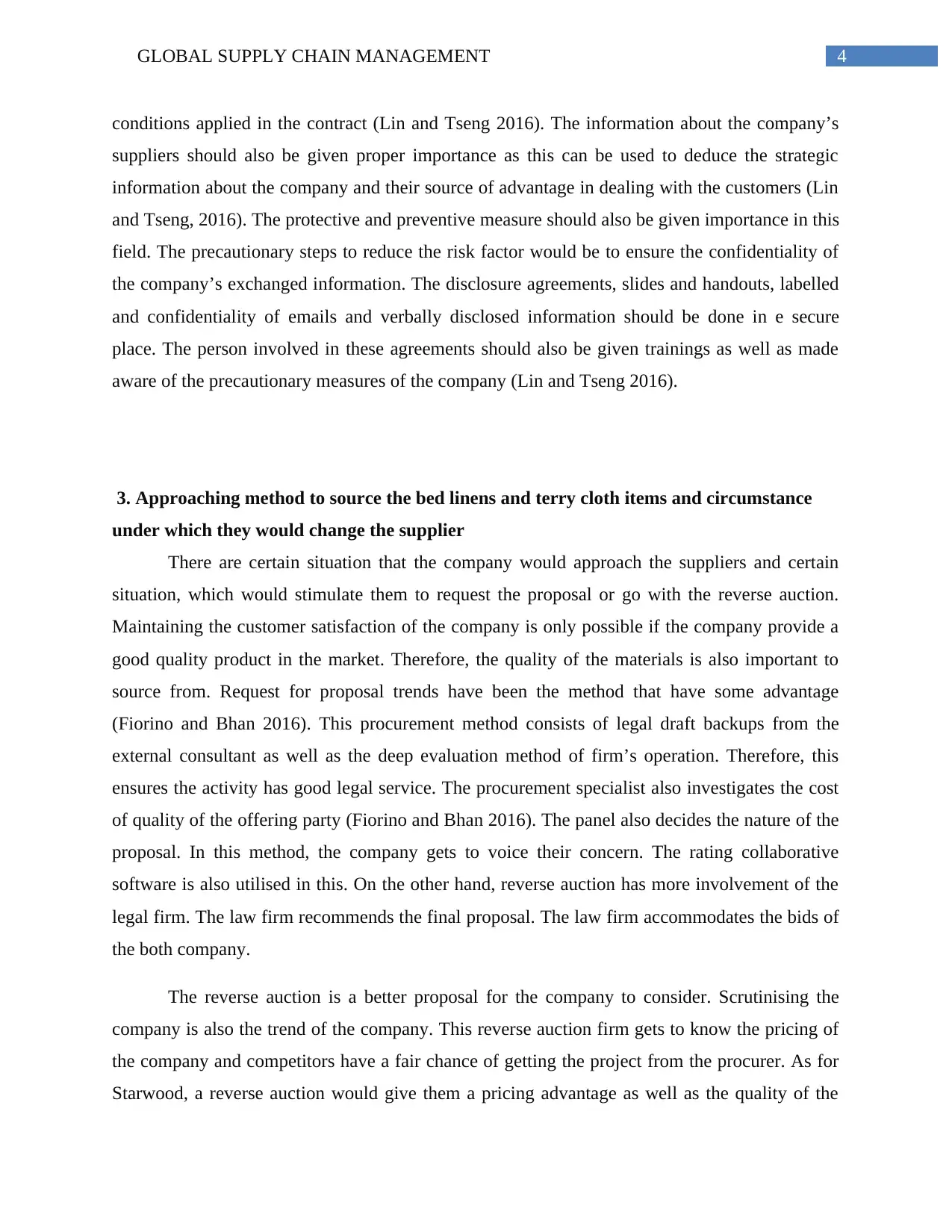
4GLOBAL SUPPLY CHAIN MANAGEMENT
conditions applied in the contract (Lin and Tseng 2016). The information about the company’s
suppliers should also be given proper importance as this can be used to deduce the strategic
information about the company and their source of advantage in dealing with the customers (Lin
and Tseng, 2016). The protective and preventive measure should also be given importance in this
field. The precautionary steps to reduce the risk factor would be to ensure the confidentiality of
the company’s exchanged information. The disclosure agreements, slides and handouts, labelled
and confidentiality of emails and verbally disclosed information should be done in e secure
place. The person involved in these agreements should also be given trainings as well as made
aware of the precautionary measures of the company (Lin and Tseng 2016).
3. Approaching method to source the bed linens and terry cloth items and circumstance
under which they would change the supplier
There are certain situation that the company would approach the suppliers and certain
situation, which would stimulate them to request the proposal or go with the reverse auction.
Maintaining the customer satisfaction of the company is only possible if the company provide a
good quality product in the market. Therefore, the quality of the materials is also important to
source from. Request for proposal trends have been the method that have some advantage
(Fiorino and Bhan 2016). This procurement method consists of legal draft backups from the
external consultant as well as the deep evaluation method of firm’s operation. Therefore, this
ensures the activity has good legal service. The procurement specialist also investigates the cost
of quality of the offering party (Fiorino and Bhan 2016). The panel also decides the nature of the
proposal. In this method, the company gets to voice their concern. The rating collaborative
software is also utilised in this. On the other hand, reverse auction has more involvement of the
legal firm. The law firm recommends the final proposal. The law firm accommodates the bids of
the both company.
The reverse auction is a better proposal for the company to consider. Scrutinising the
company is also the trend of the company. This reverse auction firm gets to know the pricing of
the company and competitors have a fair chance of getting the project from the procurer. As for
Starwood, a reverse auction would give them a pricing advantage as well as the quality of the
conditions applied in the contract (Lin and Tseng 2016). The information about the company’s
suppliers should also be given proper importance as this can be used to deduce the strategic
information about the company and their source of advantage in dealing with the customers (Lin
and Tseng, 2016). The protective and preventive measure should also be given importance in this
field. The precautionary steps to reduce the risk factor would be to ensure the confidentiality of
the company’s exchanged information. The disclosure agreements, slides and handouts, labelled
and confidentiality of emails and verbally disclosed information should be done in e secure
place. The person involved in these agreements should also be given trainings as well as made
aware of the precautionary measures of the company (Lin and Tseng 2016).
3. Approaching method to source the bed linens and terry cloth items and circumstance
under which they would change the supplier
There are certain situation that the company would approach the suppliers and certain
situation, which would stimulate them to request the proposal or go with the reverse auction.
Maintaining the customer satisfaction of the company is only possible if the company provide a
good quality product in the market. Therefore, the quality of the materials is also important to
source from. Request for proposal trends have been the method that have some advantage
(Fiorino and Bhan 2016). This procurement method consists of legal draft backups from the
external consultant as well as the deep evaluation method of firm’s operation. Therefore, this
ensures the activity has good legal service. The procurement specialist also investigates the cost
of quality of the offering party (Fiorino and Bhan 2016). The panel also decides the nature of the
proposal. In this method, the company gets to voice their concern. The rating collaborative
software is also utilised in this. On the other hand, reverse auction has more involvement of the
legal firm. The law firm recommends the final proposal. The law firm accommodates the bids of
the both company.
The reverse auction is a better proposal for the company to consider. Scrutinising the
company is also the trend of the company. This reverse auction firm gets to know the pricing of
the company and competitors have a fair chance of getting the project from the procurer. As for
Starwood, a reverse auction would give them a pricing advantage as well as the quality of the
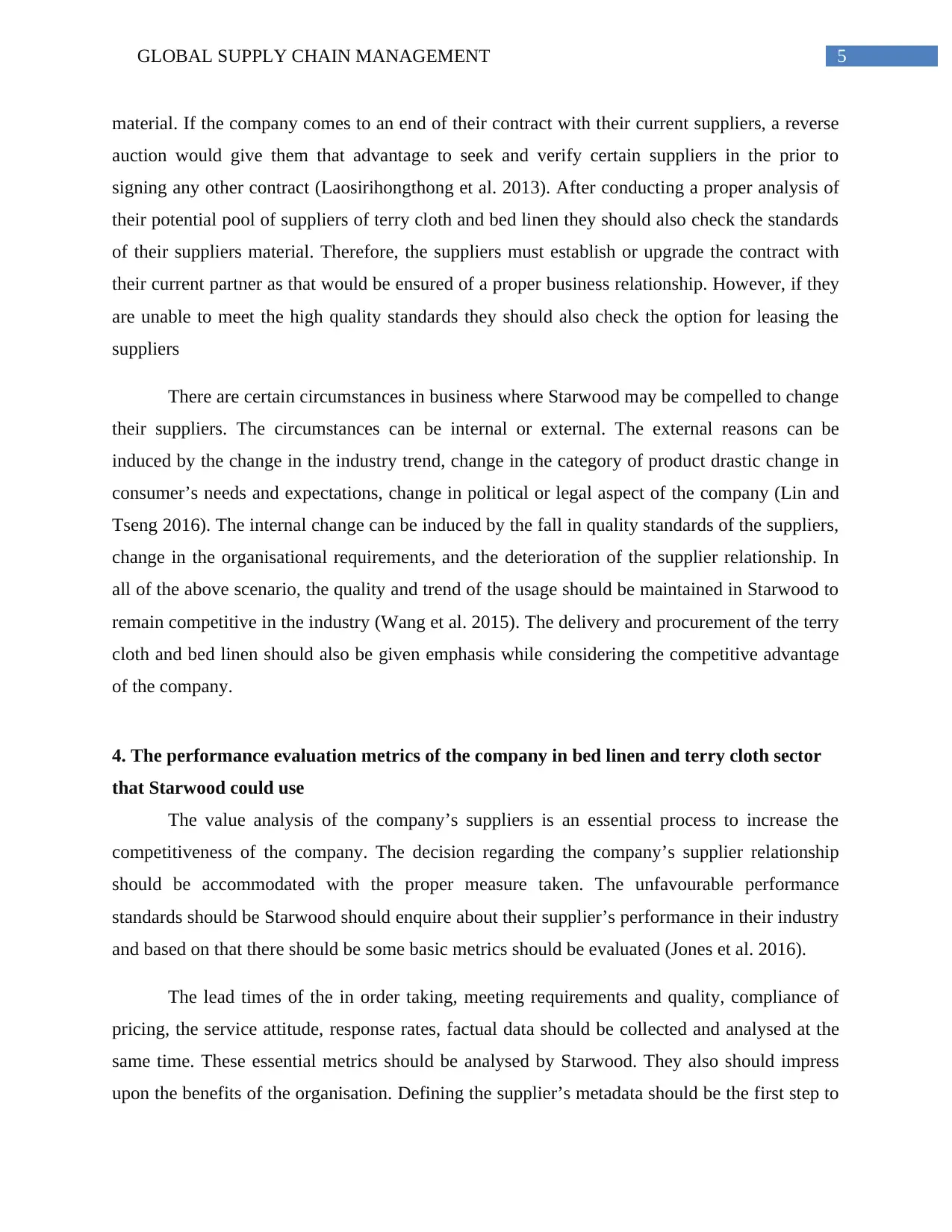
5GLOBAL SUPPLY CHAIN MANAGEMENT
material. If the company comes to an end of their contract with their current suppliers, a reverse
auction would give them that advantage to seek and verify certain suppliers in the prior to
signing any other contract (Laosirihongthong et al. 2013). After conducting a proper analysis of
their potential pool of suppliers of terry cloth and bed linen they should also check the standards
of their suppliers material. Therefore, the suppliers must establish or upgrade the contract with
their current partner as that would be ensured of a proper business relationship. However, if they
are unable to meet the high quality standards they should also check the option for leasing the
suppliers
There are certain circumstances in business where Starwood may be compelled to change
their suppliers. The circumstances can be internal or external. The external reasons can be
induced by the change in the industry trend, change in the category of product drastic change in
consumer’s needs and expectations, change in political or legal aspect of the company (Lin and
Tseng 2016). The internal change can be induced by the fall in quality standards of the suppliers,
change in the organisational requirements, and the deterioration of the supplier relationship. In
all of the above scenario, the quality and trend of the usage should be maintained in Starwood to
remain competitive in the industry (Wang et al. 2015). The delivery and procurement of the terry
cloth and bed linen should also be given emphasis while considering the competitive advantage
of the company.
4. The performance evaluation metrics of the company in bed linen and terry cloth sector
that Starwood could use
The value analysis of the company’s suppliers is an essential process to increase the
competitiveness of the company. The decision regarding the company’s supplier relationship
should be accommodated with the proper measure taken. The unfavourable performance
standards should be Starwood should enquire about their supplier’s performance in their industry
and based on that there should be some basic metrics should be evaluated (Jones et al. 2016).
The lead times of the in order taking, meeting requirements and quality, compliance of
pricing, the service attitude, response rates, factual data should be collected and analysed at the
same time. These essential metrics should be analysed by Starwood. They also should impress
upon the benefits of the organisation. Defining the supplier’s metadata should be the first step to
material. If the company comes to an end of their contract with their current suppliers, a reverse
auction would give them that advantage to seek and verify certain suppliers in the prior to
signing any other contract (Laosirihongthong et al. 2013). After conducting a proper analysis of
their potential pool of suppliers of terry cloth and bed linen they should also check the standards
of their suppliers material. Therefore, the suppliers must establish or upgrade the contract with
their current partner as that would be ensured of a proper business relationship. However, if they
are unable to meet the high quality standards they should also check the option for leasing the
suppliers
There are certain circumstances in business where Starwood may be compelled to change
their suppliers. The circumstances can be internal or external. The external reasons can be
induced by the change in the industry trend, change in the category of product drastic change in
consumer’s needs and expectations, change in political or legal aspect of the company (Lin and
Tseng 2016). The internal change can be induced by the fall in quality standards of the suppliers,
change in the organisational requirements, and the deterioration of the supplier relationship. In
all of the above scenario, the quality and trend of the usage should be maintained in Starwood to
remain competitive in the industry (Wang et al. 2015). The delivery and procurement of the terry
cloth and bed linen should also be given emphasis while considering the competitive advantage
of the company.
4. The performance evaluation metrics of the company in bed linen and terry cloth sector
that Starwood could use
The value analysis of the company’s suppliers is an essential process to increase the
competitiveness of the company. The decision regarding the company’s supplier relationship
should be accommodated with the proper measure taken. The unfavourable performance
standards should be Starwood should enquire about their supplier’s performance in their industry
and based on that there should be some basic metrics should be evaluated (Jones et al. 2016).
The lead times of the in order taking, meeting requirements and quality, compliance of
pricing, the service attitude, response rates, factual data should be collected and analysed at the
same time. These essential metrics should be analysed by Starwood. They also should impress
upon the benefits of the organisation. Defining the supplier’s metadata should be the first step to
⊘ This is a preview!⊘
Do you want full access?
Subscribe today to unlock all pages.

Trusted by 1+ million students worldwide
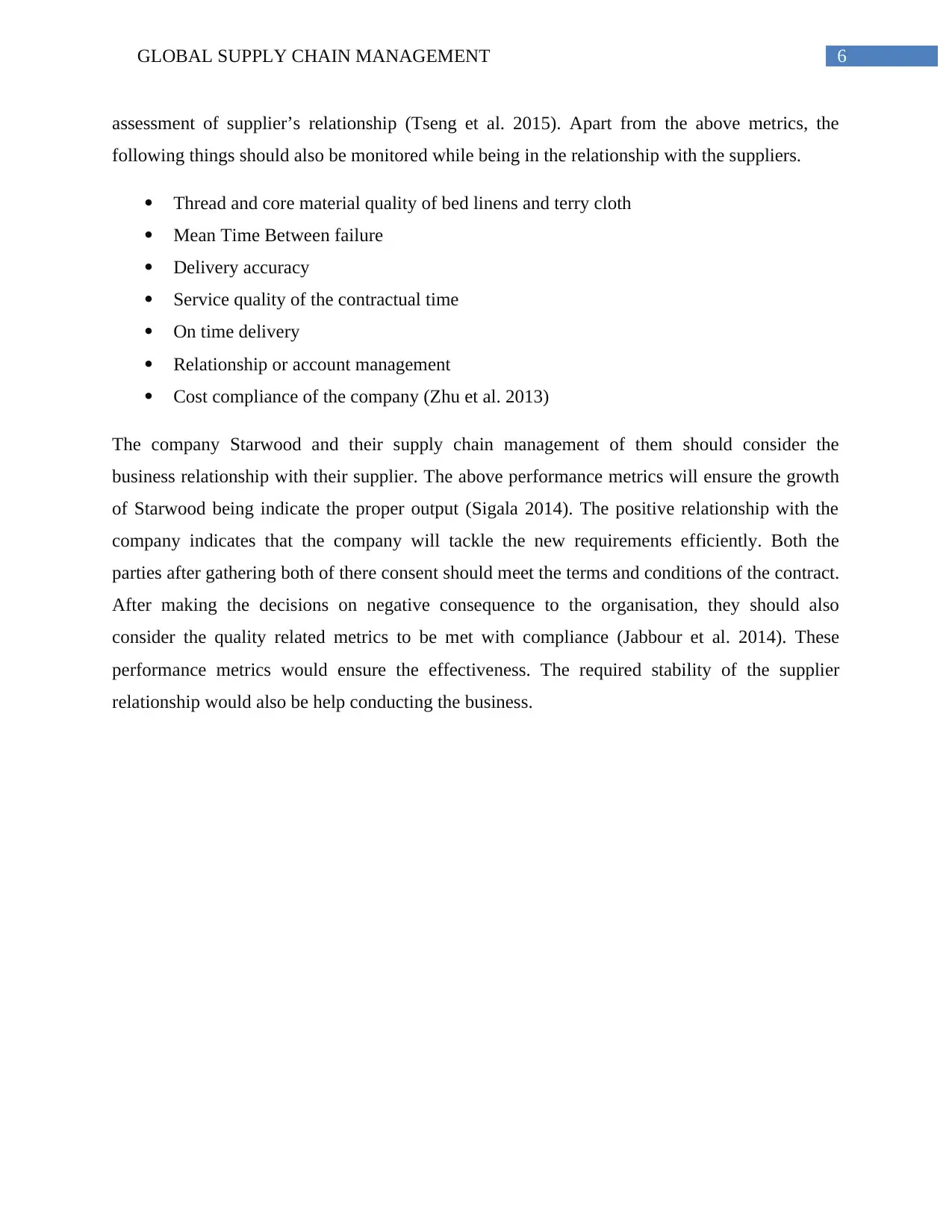
6GLOBAL SUPPLY CHAIN MANAGEMENT
assessment of supplier’s relationship (Tseng et al. 2015). Apart from the above metrics, the
following things should also be monitored while being in the relationship with the suppliers.
Thread and core material quality of bed linens and terry cloth
Mean Time Between failure
Delivery accuracy
Service quality of the contractual time
On time delivery
Relationship or account management
Cost compliance of the company (Zhu et al. 2013)
The company Starwood and their supply chain management of them should consider the
business relationship with their supplier. The above performance metrics will ensure the growth
of Starwood being indicate the proper output (Sigala 2014). The positive relationship with the
company indicates that the company will tackle the new requirements efficiently. Both the
parties after gathering both of there consent should meet the terms and conditions of the contract.
After making the decisions on negative consequence to the organisation, they should also
consider the quality related metrics to be met with compliance (Jabbour et al. 2014). These
performance metrics would ensure the effectiveness. The required stability of the supplier
relationship would also be help conducting the business.
assessment of supplier’s relationship (Tseng et al. 2015). Apart from the above metrics, the
following things should also be monitored while being in the relationship with the suppliers.
Thread and core material quality of bed linens and terry cloth
Mean Time Between failure
Delivery accuracy
Service quality of the contractual time
On time delivery
Relationship or account management
Cost compliance of the company (Zhu et al. 2013)
The company Starwood and their supply chain management of them should consider the
business relationship with their supplier. The above performance metrics will ensure the growth
of Starwood being indicate the proper output (Sigala 2014). The positive relationship with the
company indicates that the company will tackle the new requirements efficiently. Both the
parties after gathering both of there consent should meet the terms and conditions of the contract.
After making the decisions on negative consequence to the organisation, they should also
consider the quality related metrics to be met with compliance (Jabbour et al. 2014). These
performance metrics would ensure the effectiveness. The required stability of the supplier
relationship would also be help conducting the business.
Paraphrase This Document
Need a fresh take? Get an instant paraphrase of this document with our AI Paraphraser
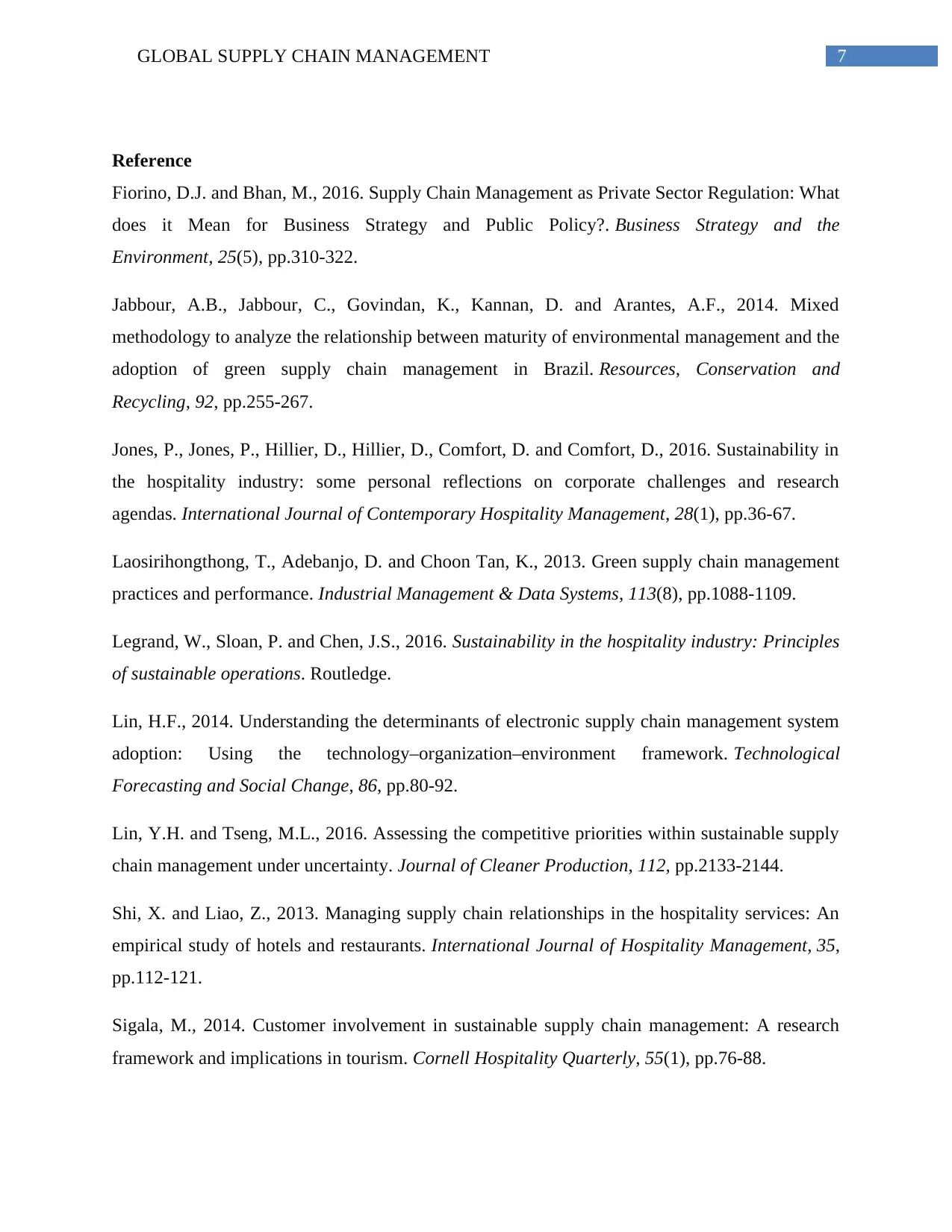
7GLOBAL SUPPLY CHAIN MANAGEMENT
Reference
Fiorino, D.J. and Bhan, M., 2016. Supply Chain Management as Private Sector Regulation: What
does it Mean for Business Strategy and Public Policy?. Business Strategy and the
Environment, 25(5), pp.310-322.
Jabbour, A.B., Jabbour, C., Govindan, K., Kannan, D. and Arantes, A.F., 2014. Mixed
methodology to analyze the relationship between maturity of environmental management and the
adoption of green supply chain management in Brazil. Resources, Conservation and
Recycling, 92, pp.255-267.
Jones, P., Jones, P., Hillier, D., Hillier, D., Comfort, D. and Comfort, D., 2016. Sustainability in
the hospitality industry: some personal reflections on corporate challenges and research
agendas. International Journal of Contemporary Hospitality Management, 28(1), pp.36-67.
Laosirihongthong, T., Adebanjo, D. and Choon Tan, K., 2013. Green supply chain management
practices and performance. Industrial Management & Data Systems, 113(8), pp.1088-1109.
Legrand, W., Sloan, P. and Chen, J.S., 2016. Sustainability in the hospitality industry: Principles
of sustainable operations. Routledge.
Lin, H.F., 2014. Understanding the determinants of electronic supply chain management system
adoption: Using the technology–organization–environment framework. Technological
Forecasting and Social Change, 86, pp.80-92.
Lin, Y.H. and Tseng, M.L., 2016. Assessing the competitive priorities within sustainable supply
chain management under uncertainty. Journal of Cleaner Production, 112, pp.2133-2144.
Shi, X. and Liao, Z., 2013. Managing supply chain relationships in the hospitality services: An
empirical study of hotels and restaurants. International Journal of Hospitality Management, 35,
pp.112-121.
Sigala, M., 2014. Customer involvement in sustainable supply chain management: A research
framework and implications in tourism. Cornell Hospitality Quarterly, 55(1), pp.76-88.
Reference
Fiorino, D.J. and Bhan, M., 2016. Supply Chain Management as Private Sector Regulation: What
does it Mean for Business Strategy and Public Policy?. Business Strategy and the
Environment, 25(5), pp.310-322.
Jabbour, A.B., Jabbour, C., Govindan, K., Kannan, D. and Arantes, A.F., 2014. Mixed
methodology to analyze the relationship between maturity of environmental management and the
adoption of green supply chain management in Brazil. Resources, Conservation and
Recycling, 92, pp.255-267.
Jones, P., Jones, P., Hillier, D., Hillier, D., Comfort, D. and Comfort, D., 2016. Sustainability in
the hospitality industry: some personal reflections on corporate challenges and research
agendas. International Journal of Contemporary Hospitality Management, 28(1), pp.36-67.
Laosirihongthong, T., Adebanjo, D. and Choon Tan, K., 2013. Green supply chain management
practices and performance. Industrial Management & Data Systems, 113(8), pp.1088-1109.
Legrand, W., Sloan, P. and Chen, J.S., 2016. Sustainability in the hospitality industry: Principles
of sustainable operations. Routledge.
Lin, H.F., 2014. Understanding the determinants of electronic supply chain management system
adoption: Using the technology–organization–environment framework. Technological
Forecasting and Social Change, 86, pp.80-92.
Lin, Y.H. and Tseng, M.L., 2016. Assessing the competitive priorities within sustainable supply
chain management under uncertainty. Journal of Cleaner Production, 112, pp.2133-2144.
Shi, X. and Liao, Z., 2013. Managing supply chain relationships in the hospitality services: An
empirical study of hotels and restaurants. International Journal of Hospitality Management, 35,
pp.112-121.
Sigala, M., 2014. Customer involvement in sustainable supply chain management: A research
framework and implications in tourism. Cornell Hospitality Quarterly, 55(1), pp.76-88.
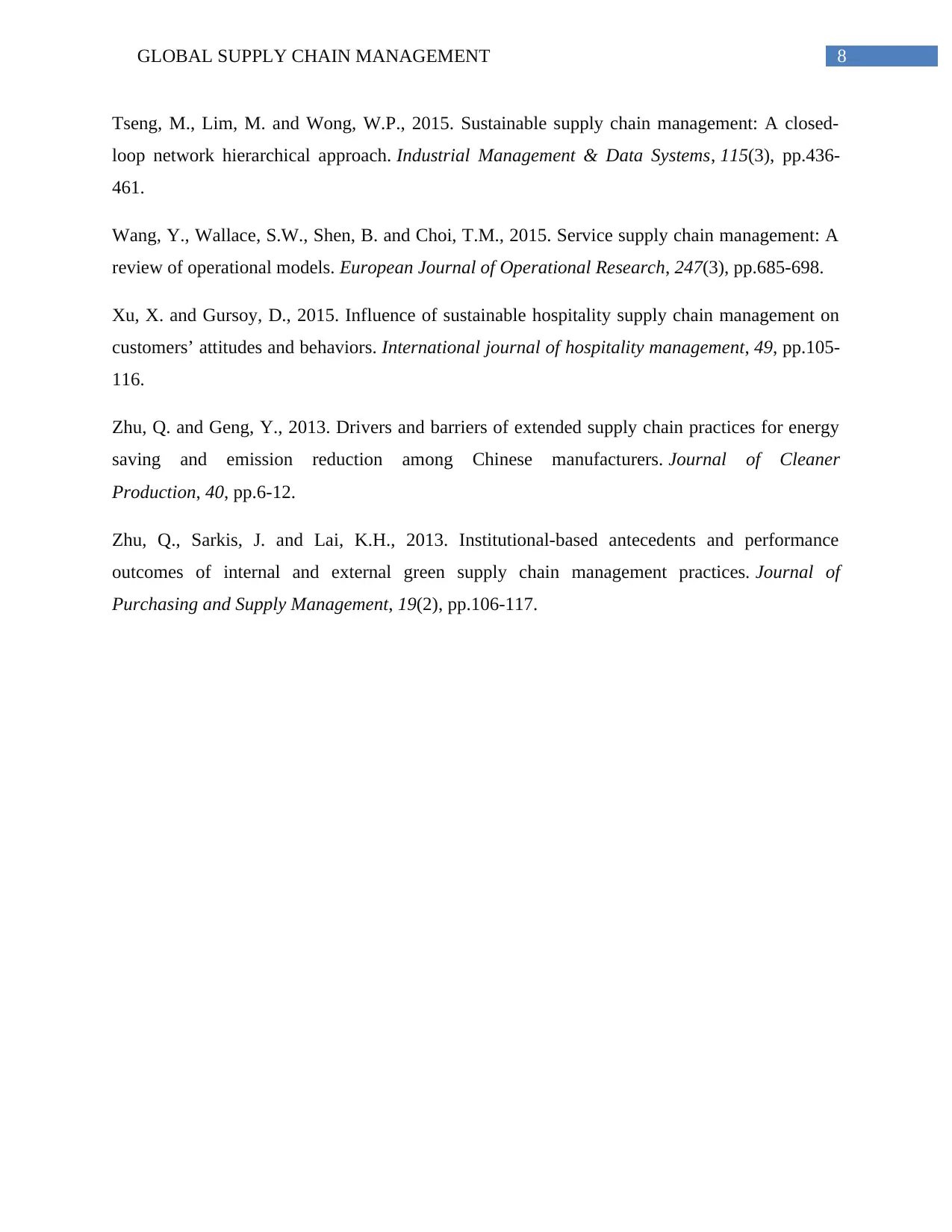
8GLOBAL SUPPLY CHAIN MANAGEMENT
Tseng, M., Lim, M. and Wong, W.P., 2015. Sustainable supply chain management: A closed-
loop network hierarchical approach. Industrial Management & Data Systems, 115(3), pp.436-
461.
Wang, Y., Wallace, S.W., Shen, B. and Choi, T.M., 2015. Service supply chain management: A
review of operational models. European Journal of Operational Research, 247(3), pp.685-698.
Xu, X. and Gursoy, D., 2015. Influence of sustainable hospitality supply chain management on
customers’ attitudes and behaviors. International journal of hospitality management, 49, pp.105-
116.
Zhu, Q. and Geng, Y., 2013. Drivers and barriers of extended supply chain practices for energy
saving and emission reduction among Chinese manufacturers. Journal of Cleaner
Production, 40, pp.6-12.
Zhu, Q., Sarkis, J. and Lai, K.H., 2013. Institutional-based antecedents and performance
outcomes of internal and external green supply chain management practices. Journal of
Purchasing and Supply Management, 19(2), pp.106-117.
Tseng, M., Lim, M. and Wong, W.P., 2015. Sustainable supply chain management: A closed-
loop network hierarchical approach. Industrial Management & Data Systems, 115(3), pp.436-
461.
Wang, Y., Wallace, S.W., Shen, B. and Choi, T.M., 2015. Service supply chain management: A
review of operational models. European Journal of Operational Research, 247(3), pp.685-698.
Xu, X. and Gursoy, D., 2015. Influence of sustainable hospitality supply chain management on
customers’ attitudes and behaviors. International journal of hospitality management, 49, pp.105-
116.
Zhu, Q. and Geng, Y., 2013. Drivers and barriers of extended supply chain practices for energy
saving and emission reduction among Chinese manufacturers. Journal of Cleaner
Production, 40, pp.6-12.
Zhu, Q., Sarkis, J. and Lai, K.H., 2013. Institutional-based antecedents and performance
outcomes of internal and external green supply chain management practices. Journal of
Purchasing and Supply Management, 19(2), pp.106-117.
⊘ This is a preview!⊘
Do you want full access?
Subscribe today to unlock all pages.

Trusted by 1+ million students worldwide
1 out of 9
Your All-in-One AI-Powered Toolkit for Academic Success.
+13062052269
info@desklib.com
Available 24*7 on WhatsApp / Email
![[object Object]](/_next/static/media/star-bottom.7253800d.svg)
Unlock your academic potential
Copyright © 2020–2025 A2Z Services. All Rights Reserved. Developed and managed by ZUCOL.